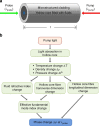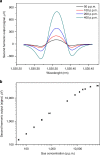Ultra-sensitive all-fibre photothermal spectroscopy with large dynamic range
- PMID: 25866015
- PMCID: PMC4403440
- DOI: 10.1038/ncomms7767
Ultra-sensitive all-fibre photothermal spectroscopy with large dynamic range
Abstract
Photothermal interferometry is an ultra-sensitive spectroscopic means for trace chemical detection in gas- and liquid-phase materials. Previous photothermal interferometry systems used free-space optics and have limitations in efficiency of light-matter interaction, size and optical alignment, and integration into photonic circuits. Here we exploit photothermal-induced phase change in a gas-filled hollow-core photonic bandgap fibre, and demonstrate an all-fibre acetylene gas sensor with a noise equivalent concentration of 2 p.p.b. (2.3 × 10(-9) cm(-1) in absorption coefficient) and an unprecedented dynamic range of nearly six orders of magnitude. The realization of photothermal interferometry with low-cost near infrared semiconductor lasers and fibre-based technology allows a class of optical sensors with compact size, ultra sensitivity and selectivity, applicability to harsh environment, and capability for remote and multiplexed multi-point detection and distributed sensing.
Figures





References
-
- Werle P. et al.. Near- and mid-infrared laser-optical sensors for gas analysis. Opt. Laser Eng. 37, 101–114 (2002) .
-
- Willer U., Saraji M., Khorsandi A., Geiser P. & Schade W. Near- and mid-infrared laser monitoring of industrial processes, environment and security applications. Opt. Laser Eng. 44, 699–710 (2006) .
-
- Shemshad J., Aminossadati S. M. & Kizil M. S. A review of developments in near infrared methane detection based on tunable diode laser. Sensor. Actuat. B Chem. 171, 77–92 (2012) .
-
- Hodgkinson J. & Tatam R. P. Optical gas sensing: a review. Meas. Sci. Technol. 24, 012004 (2013) .
-
- Culshaw B., Stewart G., Dong F., Tandy C. & Moodie D. Fibre optic techniques for remote spectroscopic methane detection - from concept to system realisation. Sensor. Actuat. B Chem. 51, 25–37 (1998) .
Publication types
LinkOut - more resources
Full Text Sources
Other Literature Sources

